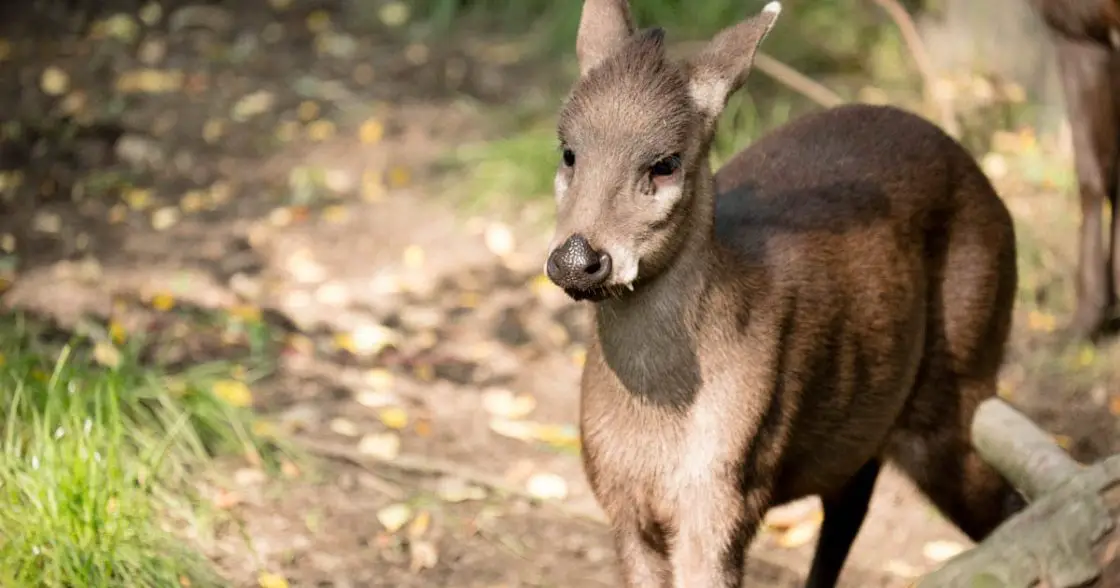The Tufted Deer (Elaphodus cephalophus) is a species native to central China and Northeastern Myanmar. It is a small deer which earned its name from the tuft of black hair on its forehead. One of the defining characteristics of the Tufted Deer are its fang-like tusks (males), which offer this deer a pre-historic appearance which is similar to the Muntjac species.
On this page we’ll share Tufted Deer facts and information about this unique deer species, including size, behavior, physical description and habitat information.
As the only surviving member of the genus Elaphodus, and with its near-threatened status due to over-hunting, The Tufted Deer is an animal worth learning more about.
Size of the Tufted Deer
- Head-Body Length – 110 to 160 cm
- Shoulder Height – 50 to 70 cm
- Tail Length – 7 to 15 cm
- Weight – 17 to 50 kg
What Does the Tufted Deer Look Like?
Elaphodus cephalophus gets its name from the distinctive tuft of hair seen on the top of its head. This tuft shows up clearly as it is darker in color than the rest of the body and is a blackish brown.
Coat and Markings
The coat is short and dense, with spiky hairs which give the Tufted Deer a shaggy appearance. In color the coat is a chocolate brown. The under parts are paler in color being a whitish grey. The head and neck are a darker grey color.
There are white markings on the face, the tip of the ears and on the underside of the tail. These areas stand out well against the dull coloration of the rest of its body. The white face markings sometimes run around the eyes and towards the top of the head.
Size
Elaphodus cephalophus is larger in size than the Muntjac species of deer, to which it is closely related.
Males are normally larger in size than females.
Like many of the Muntjac deer species, males have well-developed upper canine teeth that protrude from the upper lip and are clearly visible. To most people these resemble fangs and give this deer an unforgettable appearance.
These tusks can grow to be up to 2.5 cm long.
Only the males carry antlers but these are small simple spikes, the pedicles of the antlers are normally as long or longer than the antlers themselves.
Tufted Deer have no upper incisors; instead they have a hard pad of gums. This is used for tugging at vegetation.
There are three subspecies of tufted deer:
- The Western Tufted Deer (E. c. cephalophus cephalophus),
- The Hubei (E. c. ichangensis), and
- The Eastern or Michie’s Tufted Deer (E. c. michianus).
The largest of these is the Western Tufted Deer, which lives in southern China.
The other subspecies live farther north, in central China.
Where Do Elaphodus Cephalophus Live?
The Tufted Deer prefers thick dense forest, mostly in hilly or mountainous areas.
When observed in the wild, it’s most common to see these deer around rivers or other sources of water.
They live at altitudes of 300-4,600 metres.
Range
Today, the range of Elaphodus cephalophus covers parts of north eastern Myanmar, and southern and central China.
They are not endangered. An estimated 500,000 live in the wild. However, hunting and habitat degradation due to logging may be causing a decrease in numbers.
We don’t know a lot about the population trends in this animal. What is known is that a large number of animals are hunted each year for their meat and fur.
What Do Tufted Deer Eat?
Their diet is made up of a variety of grasses and herbaceous plants found on the hill and mountainsides where Elaphodus cephalophus lives.
How Long Do Elaphodus cephalophus Live?
In captivity Tufted Deer can live for up to 15 years. As with most deer, their lifespan decreases in the wild.
Mating Habits & Reproduction in Tufted Deer
Mating takes place in the late Autumn or early Winter. They have a distinct short bark like rut call.
Males may fight using their tusks over the territories and who gets the right to breed with receptive females.
Females breed with males that are in close proximity, and some live in a pair bond and only breed with their partner.
These deer will generally bear a single fawn after a 175 to 185 day long gestation period.
Young Elaphodus cephalophus have spots at birth. These spots fade with age. Does wean their young at about 6 months of age and reach maturity at about 18 months.
Little is known about the reproductive habits of this species, as not much research has been conducted.
Unique Behavior
The Tufted Deer leads a mostly solitary life, but does sometimes form pair bonds.
They live in small well-defended territories where they form a network of well-worn tracks through their territory along their most used trails.
Tufted Deer feed mostly at dawn and at dusk, resting through the middle part of the day.
They hold their tail high when feeding or running, exposing its white underside. When alarmed they emit a short bark like call. They have a number of predators including the snow leopard.


